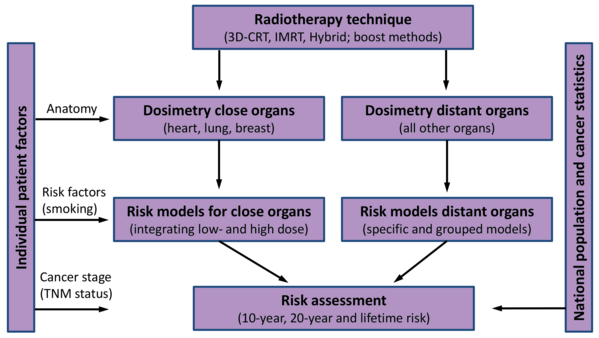Overview of PASSOS methodology
Breast-cancer radiotherapy (RT) reduces the recurrence rates and improves patient survival. However, it also increases the incidence of second cancers and of heart disease. These radiation-induced long-term health risks become increasingly important with improved cure rates and prolonged patient survival. Radiation doses to nearby as well as distant organs strongly vary between different irradiation techniques and among individual patients. To provide personalized estimates of long-term health risks, this dosimetric information must be combined with models for radiation-induced risk of second primary cancer and heart disease.
In breast-cancer RT, usually the whole breast is irradiated uniformly, and an additional boost to the tumor bed is applied. Organs close to the treated breast (heart, lung, contralateral breast) receive
very high doses with steep dose gradients. Dose distributions in these organs can depend strongly on the applied method, but can also largely differ among individuals depending on anatomic properties. In addition, also distant organs experience substantial radiation exposures that are dependent on the treatment method and poorly classified. In PASSOS a systematic characterization of exposures for close and distant organs was performed.
Radiation risk models after breast cancer RT must be developed for cancer and heart disease.
Due to the very large dose range, in particular for the heart, lung and contralateral breast, risk estimates from high-dose radiotherapy studies must be combined with low- to mid-dose studies from radioepidemiological cohorts. Furthermore, individual risk factors like smoking must be taken into account.
Figure 1 gives an overview of the applied methodology. The PASSOS software combines the dosimetric information with the risk models and can calculate long-term spontaneous and radiation-induced risk for various cancer sites and heart disease. Lifetime risk is reported together with the risk after specified times after treatment, e.g. after 10 or 20 years. Currently, the software is in the testing phase, and will afterwards be made freely available.

Figure 1: PASSOS scheme to calculate personalized lifetime risk estimates after breast cancer radiotherapy.
Contact: Dr. Markus Eidemüller
Eidemüller M, Simonetto C, Kundrát P, Ulanowski A, Shemiakina E, Güthlin D,
Rennau H, Remmele J, Hildebrandt G, Wolf U. Long-term health risk after breast cancer radiotherapy: overview of PASSOS methodology and software. Radiat Prot Dosimetry 183(1-2) (2019) 259-263. doi.org/10.1093/rpd/ncy219